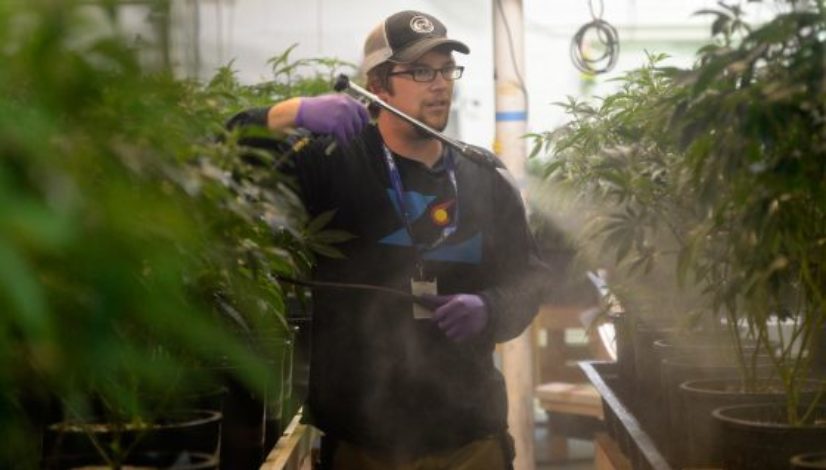Op-ed: Five years after Amendment 64, Colorado’s marijuana crop is getting greener

Published: Nov 16, 2017, 10:24 am • Updated: Nov 16, 2017, 10:24 am
By Nick Johnson, Special To The Cannabist
After marijuana’s November 2012 victory at the Colorado ballot box, voters and state officials seemed oblivious to the fact that they had just green-lighted a huge agricultural industry.
Five years after Coloradans legalized recreational marijuana with the passage of Amendment 64, the state is more familiar with marijuana’s environmental impact, prompting some positive change in regulation and within the cannabis industry itself.
But the work isn’t finished.
Colorado was in unchartered waters as it embarked on implementation of Amendment 64 in late 2012 and 2013, but there was still reason in those early days to believe that environmental issues would prove paramount in the legalization of recreational marijuana.
The state could have looked to California – at the time, 16 years into medical marijuana legalization – for a glimpse at the task at hand. For instance, an April 2012 peer-reviewed study published in the journal Energy Policy determined that California’s indoor marijuana crop emitted as much CO2 as 3 million cars. The report found the grow ops were contributing to the climate shift that exacerbated the effects of drought.
Four months prior to the 2012 election, the Denver Post reported that many of the state’s farmers, ranchers and towns suffered from “severe to moderate drought.” The reporting highlighted concerns over water supplies and conservation efforts from across the parched state, from Greeley to Steamboat to Aspen. Development and population growth along the Front Range were straining Colorado’s water supply just as a warming climate was drying up more and more of that supply.
Despite existing evidence of marijuana’s environmental effects, Colorado Gov. John Hickenlooper’s Task Force on the Implementation of Amendment 64 failed to make any environmental recommendations in its March 2013 final report. In contrast, Washington State, which also legalized marijuana in 2012, commissioned a third-party environmental impact report published in September 2013 and allowed outdoor cannabis cultivation.
Colorado did neither.
The state restricted marijuana grows to “a fully enclosed and locked space,” effectively banning outdoor grows and some greenhouse facilities that could have lessened the industry’s carbon footprint. In Denver, retail marijuana outfits snapped up warehouse space like candy, and the unsustainable agricultural model developed during prohibition dominated Colorado’s legal cannabis industry.
Pesticide use forced the state to consider environmental regulation of cannabis cultivation. In spring 2015 – more than a year after recreational marijuana sales launched in Colorado — Denver Department of Environmental Health (DEH) quarantined or destroyed tens of thousands of plants from 11 growing facilities after inspectors suspected use of unauthorized pesticides.
The raids prompted Hickenlooper in November 2015 to issue an executive order directing state agencies to address pesticide use on marijuana crops, and by January 2016 Colorado lawmakers drafted Senate Bill 16-015, which called for the state’s agriculture department to clarify which pesticides could be applied to legal marijuana crops. Governor Hickenlooper signed the bill into law that March.
Related stories
- Spokane County cannabis farmers will have to register at air pollution office
- Colorado Divide: Is hemp the answer for a rural county hoping to rely less on mining?
- Op-ed: America’s past holds clues for solving current issues with marijuana industry
- California’s cannabis farms under scrutiny to reduce their environmental impact
- Growing weed has a bad rap for harming the environment. Some growers are trying to change that
Attention to energy use came later that summer, when Xcel energy officials reported that marijuana growing facilities accounted for about half of a 1.2-percent increase in Denver’s electrical demand.
As marijuana’s energy use continued to make headlines, the DEH put together the Cannabis Sustainability Workgroup “to determine best practices” for the industry. Among the group’s members are Nick Hice and Kayvan Khalatbari, founding partners of Denver Relief, one of the city’s oldest and most prominent advocates for sustainable cannabis; John-Paul Maxfield, founder of the Organic Cannabis Association (now known as the Cannabis Certification Council); and Amy Tancig-Andrle of L’Eagle, a self-proclaimed “sustainable and zero-waste” marijuana producer. In 2016 the DEH also began hosting the annual Cannabis Sustainability Symposium, and manuals for best practices are now publicly available on the DEH website.
Meanwhile, as Colorado’s water crisis continues to unfold, Denver Water has plans to send more recycled water to cannabis crops, and the utility’s officials have recently been impressed with growers’ own water-recycling efforts.
Experience and adaptation have helped Colorado and its five-year-old cannabis industry correct the initial neglect of environmental concerns, making Colorado cannabis far more sustainable in 2017 than it was when rec shops first opened in 2014. Even some marijuana consumers are becoming more selective about the weed they purchase at dispensaries, a trend that will hopefully continue as the industry matures.
But there is work still to do. The majority of Colorado’s marijuana is still grown indoors, and too many growers still rely on non-organic fertilizers and pesticides to keep their plants healthy. Growers and other members of the industry must continue to put pressure on their fellow canna-businesses to incorporate more sustainable production methods. Meanwhile, the industry still faces the specter of federal enforcement via the Controlled Substances Act under U.S. Attorney General Jeff Sessions, who has repeatedly made it known he is no friend of Mary Jane. Even a partial shutdown of legalization would cripple recent efforts to make the cannabis crop more sustainable.
Overall, though, developments in Colorado’s cannabis industry over the past five years suggest that the state has learned a great deal about the agricultural issues surrounding cannabis. If current trends continue, Colorado’s cannabis industry will soon become a worthy model for other states seeking to re-legalize marijuana.
Nick Johnson is an historian based in Longmont, Colorado. He is the author of the new book Grass Roots: A History of Cannabis in the American West.
Topics: Colorado, commentary, commercial marijuana growing, environmental impact, growing marijuana in colorado, sustainability




